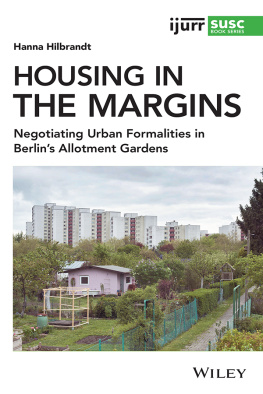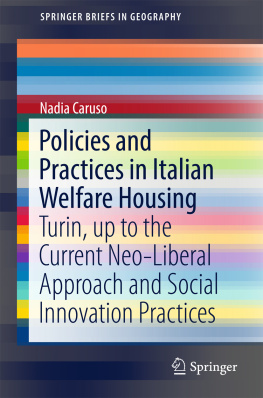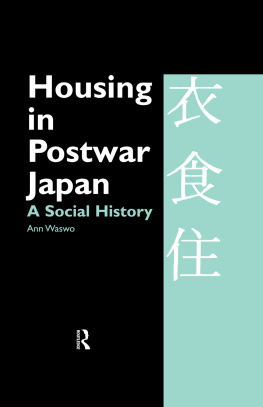LIVING ON THE MARGINS: SOCIAL ACCESS TO SHELTER IN URBAN SOUTH ASIA
Living on the Margins: Social Access to Shelter in Urban South Asia
Navtej K. Purewal
Development Studies/Sociology, University of Manchester
First published 2000 by Ashgate Publishing
Reissued 2018 by Routledge
2 Park Square, Milton Park, Abingdon, Oxon OX14 4RN
711 Third Avenue, New York, NY 10017, USA
Routledge is an imprint of the Taylor & Francis Group, an informa business
Copyright Navtej K. Purewal 2000
All rights reserved. No part of this book may be reprinted or reproduced or utilised in any form or by any electronic, mechanical, or other means, now known or hereafter invented, including photocopying and recording, or in any information storage or retrieval system, without permission in writing from the publishers.
Notice:
Product or corporate names may be trademarks or registered trademarks, and are used only for identification and explanation without intent to infringe.
Publisher's Note
The publisher has gone to great lengths to ensure the quality of this reprint but points out that some imperfections in the original copies may be apparent.
Disclaimer
The publisher has made every effort to trace copyright holders and welcomes correspondence from those they have been unable to contact.
A Library of Congress record exists under LC control number: 00109565
ISBN 13: 978-1-138-72877-6 (hbk)
ISBN 13: 978-1-315-19040-2 (ebk)
There are a number of individuals and families to whom I am greatly indebted for their roles in the process and completion of this book. First and foremost, to the two closest to me, Virinder for being there every step of the way and Nuvpreet for inspiration and meaning. To my own parents and brother for their good wishes along the way. To my parents in-law for their unconditional moral and practical support. Thanks also go to the extended Kalra, Purewal, Sira and Bedi families for making the fieldwork experience in Punjab like being at home.
For hospitality and institutional sponsorship at Guru Nanak Dev University (Amritsar), I am grateful to Dr. Jasmeet Kaur Sandhu, Professor Ranvinder Singh Sandhu and, of course, Sandeep. A special thanks to Dr. Harjinder Singh for insightful advice and direction and also to Professor Harish Puri. To Pankaj Bawa and Harpreet Ghai for showing me the streets of Amritsar on the back of a scooter and whose diligence in conducting the survey are greatly appreciated. To the Mann family for their kindness during the year in Amritsar. For helping to make a home away from home, to Asha.
On to my support in Britain, to Laura, Kath, Kathy, Sanjay, John and Raminder for friendship and encouragement. A special thanks to Nilofer, Kabir, Shahina, Bilu and Manjit for their patience and understanding. In the U.S. and beyond, to dear and old friends Mamta, Jenn and Kim. To the Punjab Research Group for continuing to pave the way for new and much needed research on Punjab. To Dr. Tasleem Shakur for supervision and guidance on the overall study.
Finally and most importantly, to the families living around the walled city in Amritsar whose struggle for decent living conditions continues.
The Focus
The opportunities available to the urban poor in the Third World to find decent accommodation for themselves are becoming increasingly narrow. Those without the monetary savings, steady incomes or the privilege of contacts required to afford or access adequate shelter find themselves on the margins. In actuality, the familiar and often stereotyped squatter settlements and other extra-legal, informal types of settlements provide a considerable proportion of the housing supply to the poor. Meanwhile, in many Third World countries the state has historically not played a particularly magnanimous role in providing social welfare. Furthermore, the recent 'down-sizing' of the state's role in social welfare provision has already had profound impacts upon the patterns of access to shelter that are now emerging. Privatisation policies, as will be argued in the book, largely rely upon already existing 'self-help' settlements which continue to attract the poor and to be the largest housing providers in many cities. As part of the same process, existing social inequalities have been exacerbated in poor residential areas without the full commitment of official policies to strive for social equity. The withdrawal of the state apparatus from direct housing provision has left many households to their own devices to find shelter in an increasingly commercialised, unaffordable sector while the parallel phenomenon of the state's encouragement of private activities has further entwined the low-income housing sector with market forces. The emerging patterns of social access to and exclusion from shelter show a socially differentiated picture which requires an interrogation of the appropriateness of certain policies and the reliance upon individual household efforts.
The poor residential communities surrounding the walled city in Amritsar are the focus of this study. They occupy a geographical place which is on the margins of the walled city as well as a metaphorically marginal position within the housing market of the city. In developing an understanding of the dynamics of development in the low-income settlements in Amritsar, the study offers a framework for examining the experiences of low-income settlements specific to the city. This book highlights a number of theoretical points. The first is that the self-help debate still holds many points of relevance to contemporary housing research. While the role that the state has played in development, and more particularly housing development, has evolved over the past few decades, the ideological debates around the extent of the state's capacity in mobilising resources for social welfare and that of the market and individual's role in the development process still remain open to discussion. Reforms to state policies from provision to assistance have fundamentally impacted upon the emerging types of settlements which often cross and challenge the dichotomy of categories like legal-illegal, formal-informal and public-private.
In developing a framework for assessing social access to housing, a comparison of some of the competing debates, mainly between the neo-marxist and self-help theorists, is made here. This is complemented by reference to recent comparative empirical studies on the formation and consolidation of low-income settlements. In doing so, the book attempts to assess the ways in which self-help and planned intervention have impacted on low-income housing systems. Patterns of social differentiation created and reinforced by both forms will be comparatively analysed in the final analysis as a means of drawing together the core issues around social access.
The Organisation of the Book
The first chapter reviews several of the themes in the literature on poverty and shelter in the Third World. These themes are addressed through the main competing theoretical perspectives within the literature of the self-help school and the neo-marxists. The ascension of self-help thought starting from the 1960s saw the ideological split between those who saw potentials in the efforts of individual households in housing improvement and those who saw the use of self-help methods as exploitative of the poor. This divergence is reflected in the case presented by the self-help theorists in favour of autonomous housing systems and the neo-marxist critique of the use of petty commodity production under capitalist conditions. The theoretical thrust of this study is introduced here in the context of the neo-marxist critique, which is further elaborated upon in the next chapter.










